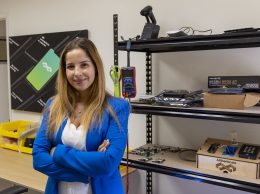Asta Fluidic takes top spot at UCSB competition
A UC Santa Barbara team developing a cheap and easy technology to test for a serious pregnancy complication is the winner of the school’s 14th annual New Venture Competition.
Asta Fluidic Technologies is developing a chip that could drastically reduce the time and cost of testing for fetomaternal hemorrhage, a condition in which the red blood cells of a fetus leak into the circulatory system of the mother. The group was led by engineering students John Herr and Alex Russell and said its technology would be affordable enough to become a “standard of care” for the 6 million pregnancies a year in the United States.
The competition is hosted by UCSB’s Technology Management Program. It awards up to $10,000 in cash prizes along with time from accounting and legal professionals to the winning teams.
More than two dozen teams participated in preliminary rounds, with six pitching to a panel of judges on May 22.
The third place team in the competition was Napses, a Web-based course management system to connect professors and students. Professors can post their course materials there, but the big difference between Napses and existing systems is that the system can automatically contact the publishers of posted material and take care of licensing content. The team included Kourosh Azin, David Campos, Katya Fomenko, Sanchit Gupta, Alexander Knittel and Prithvi Sathiya. “They not only took care of digitizing the readers, but they addressed something else no one is addressing, which is the copyrights,” Jim Sloan, one of the judges, said of team when handing out the award.
But the surprise winner of the night was Komodo Interactive, which won both second place and the People’s Choice Award, which was voted on by the audience. Ben Shukman and Patrick Clary created a line of customizable battle robots that are controlled with a video-game-like controller or an iPhone. The bots have a central core that would sell for $50, and accessory arms, legs and other weapons would cost $11 each. Different weapons do different damage to the video-game-like “health bars” of each bot during battle.
The judges had tough questions about the company’s business model – it would be easy for a large toy maker to crush the young company if the idea started to take off. But nearly everyone in the room agreed that even if they weren’t sure about investing in the company, the product looked so fun that they’d probably buy it for themselves or their children.
“Because of the vast amount of permutations possible, no two robots will be alike,” Shukman told the crowd during his pitch.










